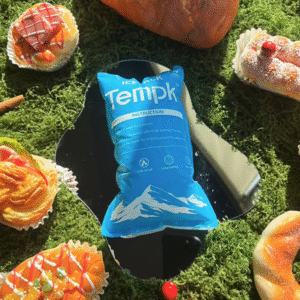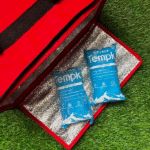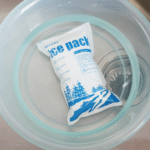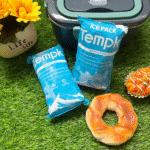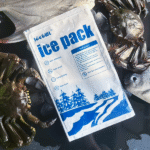How Cold Chain in the Pharmaceutical Industry Is Evolving in 2025
You rely on the cold chain in the pharmaceutical industry every time you receive a vaccine, insulin pen or biologic therapy. بواسطة 2025, more than eighty five percent of biologics need refrigerated storage and nearly half of vaccines are lost because of poor temperature control. Precise temperature management protects patient safety, reduces waste and enables advanced therapies like cell and gene treatments that require cryogenic conditions. في هذا الدليل, you’ll learn why the cold chain is essential, what technologies and regulations are shaping it in 2025, and how you can strengthen your own operations.
Why is a reliable cold chain vital for biologics, vaccines and specialty drugs? – includes long tail keywords about temperature requirements and product categories.
How are IoT, منظمة العفو الدولية, blockchain and digital twins transforming cold chain logistics? – features long tail keywords on smart sensors and predictive analytics.
What regulations do you need to comply with in 2025? – covers DSCSA, EU PPWR, FSMA 204 and other compliance topics.
Which market trends offer opportunities for growth and innovation? – discusses market size, CAGR and regional insights.
How do sustainability and innovation intersect to drive greener pharmaceutical logistics? – explores eco friendly materials, renewable energy and hydrogen trucks.
Why Is Cold Chain Vital for Biologics and Vaccines?
إجابة مباشرة
Maintaining a cold chain is critical because most modern therapies lose potency outside narrow temperature ranges. زيادة 85 % of biologics require refrigerated storage, and nearly half of vaccines are wasted globally due to inadequate temperature control. Even common drugs like GLP 1 weight loss treatments must remain between 2 °C and 8 °C. Cell and gene therapies are even more demanding, often requiring cryogenic temperatures of −80 °C to −150 °C. Without reliable cold chain management, proteins denature, potency drops and patients may receive ineffective or harmful medicine.
التفسير الموسع
From the patient’s perspective, the cold chain ensures that sensitive medicines stay effective from manufacturing to administration. Biologics are complex molecules that degrade quickly when exposed to heat or temperature swings, so they require consistent refrigeration. وفقا لتحليل الصناعة, 14 of the top 20 best selling drugs by revenue must be stored between 2 درجة مئوية و 8 درجة مئوية. The rise of cell and gene therapies adds further complexity; these treatments often need cryogenic storage below −80 °C and have short half lives, making logistics time critical. Weight loss drugs and mRNA vaccines also increase demand for cold chain capacity. بدون التحكم السليم في درجة الحرارة, vaccines and biologics may lose efficacy, leading to treatment failures and public health risks. Robust cold chain systems protect product integrity, reduce waste and support the growth of advanced therapies.
Temperature ranges and product categories
The following table summarises common therapy categories and their required temperature ranges. Understanding these ranges helps you choose the right packaging and transport solutions.
| فئة العلاج | نطاق درجة الحرارة النموذجي | توضيح | الآثار العملية |
| Standard vaccines & peptides | 2 °C – 8 °C (مبردة) | Many childhood vaccines, peptides and GLP 1 agonists remain stable at fridge temperatures. | Use insulated shippers with gel packs; maintain “fridge level” conditions during transit. |
| البيولوجيا (الأنسولين, الأجسام المضادة أحادية النسيلة) | 2 °C – 8 °C short term; −20 °C to −80 °C long term | Long term storage may require freezing; real time monitors are essential. | Invest in cold rooms or freezers that can transition between temperatures; implement continuous monitoring. |
| خلية & العلاجات الجينية | -80 درجة مئوية إلى -150 درجة مئوية (المبردة) | Therapies such as CAR T and mRNA vaccines require ultra cold conditions. | Use cryogenic freezers or liquid nitrogen vapour storage; portable cryogenic shippers for clinical delivery. |
| Metabolic and weight loss drugs | 2 °C – 8 °C | GLP 1 agonists must remain within a narrow refrigerated range to maintain potency. | Coordinate just in time deliveries; monitor for counterfeit products and temperature excursions. |
نصائح وإرشادات عملية
خريطة محفظة المنتجات الخاصة بك: Identify which therapies require refrigerated, frozen or cryogenic storage. Align them with appropriate equipment, such as insulated shippers, portable cryogenic containers or refrigerated containers.
Validate packaging: Use pre qualified shippers and perform thermal modelling to ensure solutions work under real world conditions. Dry ice is essential for temperatures below −78.5 °C, whereas phase change materials (PCMS) work well for 2 °C–8 °C shipments.
تدريب فريقك: Many cold chain failures result from human error. Provide clear SOPs for packing, preconditioning refrigerants and handling cryogenic materials.
خطط للطوارئ: Keep backup generators, extra refrigerants and alternative routes in case of power outages or delays. AI driven route planning can anticipate disruptions and suggest rerouting.
مثال العالم الحقيقي: A large speciality pharmacy implemented IoT sensors and predictive analytics across its refrigerated trucks. When sensors detected a compressor starting to fail, the system automatically alerted maintenance crews, who replaced the unit before any products were compromised. This avoided a multimillion dollar recall and improved their reputation for reliability.
How Are IoT, منظمة العفو الدولية, Blockchain and Digital Twins Transforming Cold Chain Logistics?
Technological innovation is driving a revolution in cold chain logistics. التكامل إنترنت الأشياء (إنترنت الأشياء) أجهزة استشعار, الذكاء الاصطناعي (منظمة العفو الدولية), blockchain و التوائم الرقمية delivers real time visibility, predictive power and transparency.
إجابة مباشرة
Smart sensors and AI predictive analytics are the backbone of modern cold chain operations. IoT devices record temperature, الرطوبة وبيانات الموقع, while AI analyses this information to forecast equipment failures or shipment delays. Blockchain creates tamper proof logs of every handoff and temperature reading, deterring counterfeit drugs and simplifying audits. Digital twins replicate supply chains in virtual space, enabling rapid decision making and continuous improvement. معاً, these technologies reduce risk, enhance compliance and cut costs.
التفسير الموسع
IoT sensors provide continuous data on environmental conditions and integrate with GPS for precise location tracking. They send alerts whenever thresholds are breached, allowing logistics teams to take corrective action before the product is compromised. AI platforms such as TransVoyant and CargoSense analyse sensor data alongside traffic and weather patterns to predict delays and recommend alternate routes. Blockchain records every step, creating a transparent, immutable history of the shipment. Digital twins replicate cold storage facilities and transport routes, enabling companies to simulate conditions, test contingency plans and identify bottlenecks.
Another important development is the integration of smart labels and RFID tags into packaging. These labels change colour or transmit data when temperature limits are exceeded. When combined with QR codes, they link to digital certificates and compliance records. AI driven control towers and predictive maintenance systems are also emerging; they forecast equipment issues and suggest repairs before failures occur.
Key technologies and benefits
| تكنولوجيا | وصف | ماذا يعني لك |
| مستشعرات إنترنت الأشياء & مراقبة في الوقت الحقيقي | Wireless devices measure temperature, الرطوبة والموقع; integrate with GPS for complete visibility. | Immediate alerts prevent product loss; data supports compliance audits and customer transparency. |
| منظمة العفو الدولية & التحليلات التنبؤية | Machine learning algorithms analyse sensor data alongside external factors like traffic and weather, predicting disruptions. | Enables route optimisation, anticipates equipment failures, reduces delays and lowers operating costs. |
| إمكانية تتبع البلوكشين | Immutable ledger records each handoff, temperature reading and route update. | Deters counterfeits, simplifies audits and builds trust with regulators and patients. |
| Digital twins | Virtual models of supply chains or storage facilities that simulate conditions and allow rapid adjustments. | Test new processes without risking shipments; identify bottlenecks and optimise operations. |
| التسميات الذكية & RFID | Labels with temperature indicators and RFID transmitters that log data and provide visible proof of compliance. | Easy verification during delivery; integrated data uploads to quality systems for seamless documentation. |
| تحسين مسار الذكاء الاصطناعي | AI analyses traffic patterns and equipment health to select the best routes. | Reduces transit times, fuel usage and emissions; ensures on time delivery. |
نصائح وإرشادات عملية
Pilot IoT sensors: Start with high risk products or routes to test sensor reliability and data integration. Evaluate battery life and communication coverage.
Invest in predictive analytics: Use AI platforms that integrate with your existing systems. Prioritise solutions that offer easy visualisation and actionable insights.
Implement blockchain gradually: Begin with critical products where traceability is legally required. Integrate blockchain records with existing ERP systems.
Adopt digital twins: Use digital models to forecast capacity needs and test alternative routing strategies before scaling up.
Educate stakeholders: Share data and insights with logistics partners, regulators and patients to build trust and encourage collaboration.
مثال: A global clinical trial sponsor deployed smart labels with RFID on all cryogenic shipments. Temperature data and location updates automatically flowed into the company’s blockchain ledger, producing an audit ready record. When a sensor alerted them to a dry ice shortage mid flight, AI predicted the impact and recommended an emergency refill at the next stop. The shipment arrived safely, and the digital record simplified regulatory review.
Illustration: Connected Cold Chain
An abstract depiction of a pharmaceutical cold chain network showing refrigerated trucks, أجهزة استشعار, AI nodes, blockchain cubes and monitoring screens. The visual emphasises connectivity, technology and sustainability.
Which Regulations Shape Cold Chain Operations in 2025?
Regulators worldwide have introduced new rules to ensure the safety, integrity and sustainability of temperature sensitive medicines. Failing to comply can lead to fines, product recalls and reputational damage.
إجابة مباشرة
Key regulations in 2025 include DSCSA, EU Packaging and Packaging Waste Regulation (ص) وFSMA 204. The Drug Supply Chain Security Act (DSCSA) requires electronic package level traceability and has staggered deadlines: manufacturers and repackagers by May 27 2025, wholesalers by August 27 2025 and dispensers with 26 or more employees by November 27 2025. ال EU PPWR (2025/40) took effect on February 11 2025, limiting empty space in packaging to 40 % by August 12 2026, mandating digital labelling by 2027 and requiring 30–65 % recycled content by 2030. FSMA 204 requires traceability records for high risk foods; compliance has been extended to July 2028, but many pharmaceutical companies follow similar standards to harmonise food and pharma logistics.
التفسير الموسع
The DSCSA aims to secure the U.S. drug supply chain by mandating electronic tracking of prescription medicines. Phase I of implementation required trading partners to exchange transaction information, history and statements; Phase II focuses on interoperable, package level systems. ال 2025 deadlines reflect the complexity of integrating diverse systems across manufacturers, wholesalers and dispensers. DSCSA compliance not only protects against counterfeit drugs but also improves recall efficiency and patient safety.
في أوروبا, ال Packaging and Packaging Waste Regulation (ص) 2025/40 introduces strict packaging efficiency rules. From August 12 2026, packaging cannot exceed 40 % empty space, encouraging right sized boxes and reducing waste. من 2027, QR codes must provide environmental information, and by 2030 packaging must meet recycled content thresholds (30-65 %). E commerce providers must offer reusable packaging options at checkout, and non EU companies shipping into the EU must appoint an EU representative.
ال قانون تحديث سلامة الأغذية (FSMA 204) primarily targets the food industry but influences pharmaceutical logistics because many facilities handle both food and medicine. It requires supply chain stakeholders to record critical tracking events (CTEs) و key data elements (KDEs) and to provide records to the FDA within 24 ساعات. Compliance has been extended to July 2028, but aligning systems now helps companies anticipate similar expectations from pharmaceutical regulators.
Compliance requirements and tips
| أنظمة | Key Requirements | What You Should Do |
| DSCSA (نحن) | Package level electronic tracing; authorised trading partners; transaction information, history and statements. | Build interoperable digital systems, adopt barcode or RFID serialization, and ensure data quality across partners. Train staff and perform mock recalls. |
| EU PPWR 2025/40 | Packaging cannot exceed 40 % empty space by Aug 2026; digital labelling (رموز الاستجابة السريعة) بواسطة 2027; recycled content thresholds by 2030; reusable options at checkout. | Audit packaging sizes, design right sized containers, develop QR code labelling, increase recycled material use and prepare reusable systems for e commerce. |
| FSMA 204 | Record CTEs and KDEs for high risk foods; maintain records for two years; provide data within 24 ساعات; use digital interoperable formats. | Adopt digital traceability solutions compatible with both food and pharma logistics. Harmonise record keeping procedures to reduce duplication. |
| الناتج المحلي الإجمالي & ممارسات التصنيع الجيدة | Ensure proper storage, prevent contamination, maintain traceability, enable recalls. | التحقق من صحة المعدات, calibrate monitoring devices, document SOPs and conduct regular inspections. |
نصائح عملية
Start early: Implement traceability and digital labelling well before deadlines to allow time for testing and training.
Conduct packaging audits: Measure empty space, assess material composition and redesign packaging to meet PPWR requirements.
Invest in digital records: Replace paper logs with secure, interoperable systems that integrate with blockchain and DSCSA guidelines.
Train staff across the supply chain: Create standard operating procedures for data entry, scanning and exception handling; ensure partners follow similar protocols.
ابق على اطلاع: Regulatory landscapes evolve rapidly. Monitor updates from the FDA, EMA and local authorities to avoid non compliance.
دراسة حالة: A mid sized pharmaceutical distributor invested in a blockchain based traceability platform ahead of DSCSA deadlines. By training staff and integrating with suppliers’ barcoding systems, they achieved error rates below 0.1 % and passed a mock FDA audit. Preparing early gave them a competitive advantage and prevented shipping delays when the 2025 deadlines took effect.
What Market Trends Offer Opportunities for Growth and Innovation?
The pharmaceutical cold chain is one of the fastest growing segments in logistics. Understanding market dynamics helps you make informed investment decisions.
إجابة مباشرة
The global pharmaceutical cold chain packaging market is valued at USD 20.05 مليار في 2025 ومن المتوقع أن يصل إلى الدولار الأمريكي 69.55 billion by 2034—a compound annual growth rate (CAGR) ل 14.82 %. North America accounts for roughly 34 % من السوق في 2024, while Asia Pacific is expected to grow at a double digit CAGR of 17.21 %. The broader cold chain logistics industry was valued at $342.8 مليار في 2023 and is forecast to exceed $1.242 تريليون بواسطة 2033. عبوة قابلة لإعادة الاستخدام, VIP systems, cell and gene therapy logistics and predictive analytics are among the fastest growing segments.
التفسير الموسع
Several factors drive this growth:
Surging biologics and cell/gene therapy demand: The cell and gene therapy CDMO market is projected to soar from USD 6.31 مليار في 2024 إلى USD 74.03 مليار من قبل 2034. These therapies require ultra cold logistics, boosting demand for cryogenic equipment and specialized packaging.
E commerce and direct to patient models: Online pharmacies and home delivery create more small, frequent shipments. Micro shipments require precise temperature control and route optimisation, increasing complexity and driving investment in agile logistics.
Strategic collaborations: Partnerships between pharmaceutical companies and logistics providers enhance reach and resilience. على سبيل المثال, COSMOS Pharmaceutical partnered with RELEX Solutions in July 2025 to implement AI driven supply chain optimisation. Tjoapack launched a real time dashboard in May 2025 to increase packaging transparency.
Regulation and traceability: Strict regulatory standards like DSCSA and PPWR drive investment in digital systems, packaging redesign and advanced monitoring. Compliance is not optional; it becomes a differentiator.
الاستدامة: Consumers and regulators demand greener solutions. Reusable packaging is projected to grow from USD 4.97 مليار في 2025 إلى USD 9.13 مليار من قبل 2034. Vacuum insulated panel (VIP) packaging could double from USD 2.5 مليار في 2025 إلى USD 5 مليار من قبل 2033. Hydrogen powered refrigeration vehicles and renewable energy systems further reduce carbon emissions.
Regional expansion: Europe dominated the drug supply chain market in 2024, but Asia Pacific is the fastest growing region. Rapid infrastructure development and healthcare expansion in China, India and Southeast Asia create opportunities for localised cold chain hubs.
Market metrics at a glance
| متري | قيمة (2025) | Forecast or Growth | تفسير |
| Pharma cold chain packaging market | دولار أمريكي 20.05 مليار | Projected to reach USD 69.55 مليار من قبل 2034; CAGR 14.82 % | Shows robust expansion driven by biologics and regulatory demands. |
| نحن. سوق التعبئة والتغليف سلسلة التبريد | دولار أمريكي 1.23 مليار في 2024 | 14.6 % CAGR من خلال 2030 | Reflects reliance on biologics, اللقاحات والعلاجات الجينية. |
| عبوة قابلة لإعادة الاستخدام | دولار أمريكي 4.97 مليار (2025) | من المتوقع أن يصل إلى الدولار 9.13 مليار من قبل 2034 | Indicates growing interest in circular economy and cost savings. |
| VIP packaging | دولار أمريكي 2.5 مليار (2025) | Could reach USD 5 مليار من قبل 2033 | Superior thermal performance drives adoption. |
| Cold chain logistics market | دولار أمريكي 342.8 مليار (2023) | Forecast to exceed USD 1.242 تريليون بواسطة 2033; CAGR 13.9 % | Highlights how temperature controlled logistics underpin both food and pharma sectors. |
| سوق التحليلات التنبؤية | دولار أمريكي 10.2 مليار (2023) | من المتوقع أن يصل إلى الدولار 63.3 مليار من قبل 2032 | Data intelligence becomes essential for proactive maintenance and forecasting. |
| خلية & gene therapy logistics | - | CDMO market expected to rise from USD 6.31 مليار (2024) إلى USD 74.03 مليار (2034) | Demands ultra cold infrastructure and specialized packaging. |
Practical tips for capitalizing on market growth
Monitor market trends: Use reliable research sources to stay aware of growth projections. Plan capacity and capital expenditure accordingly.
Diversify logistics partners: Work with multiple carriers and consider establishing regional hubs to reduce transit times and risk. This is particularly important as global trade tensions and tariffs can disrupt supply chains.
Invest in cryogenic capacity: With cell and gene therapies booming, ensure access to freezers that can maintain temperatures below −80 °C and portable cryogenic shippers.
Adopt reusable and VIP packaging: Evaluate return logistics and cleaning protocols for reusable containers. VIPs provide superior insulation and reduce refrigerant needs.
Leverage predictive analytics: Use AI to forecast demand, optimize inventory and plan maintenance for equipment like refrigeration units and delivery trucks.
Actionable example: A biosimilar manufacturer expanded into Southeast Asia by setting up regional hubs in Tokyo and Mumbai, as the region is emerging as an innovation center for blockchain, solar powered storage and AI logistics. By pairing predictive analytics with local partnerships, the company reduced transit times by 30 % and met stringent GDP requirements.
How Sustainability and Innovation Drive Greener Pharmaceutical Cold Chains
Environmental responsibility is no longer optional; it’s a business imperative. Regulators, investors and patients expect pharmaceutical companies to reduce their carbon footprint while maintaining product integrity.
إجابة مباشرة
Adopting eco friendly materials, renewable energy and cleaner transport reduces emissions and supports long term cost savings. Industry surveys show that 43 % of pharma professionals consider environmental issues the most important ESG priority. Global initiatives such as the EU PPWR mandate recycled content, while companies invest in hydrogen powered refrigeration vehicles and solar powered storage units to cut emissions. Reusable packaging and biodegradable insulation materials help reduce waste, aligning with circular economy principles.
التفسير الموسع
المبردات الصديقة للبيئة: Traditional refrigerants like hydrofluorocarbons (مركبات الكربون الهيدروفلورية) have high global warming potential. New systems use natural refrigerants such as CO₂ and ammonia, which comply with regulatory phase outs and lower emissions. الطاقة المتجددة: Solar and wind powered cold storage units decrease reliance on fossil fuels and hedge against energy price volatility. Hydrogen powered refrigeration trucks use fuel cells to power refrigeration units, cutting tailpipe emissions and supporting net zero targets.
التغليف المستدام: ألواح معزولة بالفراغ (كبار الشخصيات) وتغيير الطور المواد (PCMS) improve thermal efficiency and can be reused. Biodegradable insulations made from seaweed based bioplastics, jute or paper reduce landfill waste. عبوات سلسلة التبريد القابلة لإعادة الاستخدام, such as returnable clinical trial containers and rental pooling systems, ومن المتوقع أن ينمو من الدولار الأمريكي 4.97 مليار في 2025 إلى USD 9.13 مليار من قبل 2034.
Modal shifts and collaborations: Shifting from air to sea freight reduces carbon emissions because air freight produces up to 47 times more CO₂ than sea transport. Collaboration across the value chain, including rental models for packaging and pooling networks, spreads costs and reduces waste.
Sustainability measures and their benefits
| يقيس | وصف | فائدة |
| Natural refrigerants (co₂, ammonia) | Replacing high GWP HFCs with natural gases. | Lower greenhouse gas emissions; compliance with regulatory phase outs. |
| الطاقة المتجددة & solar storage | Installing solar panels and using wind powered facilities. | Cuts operational costs; provides resilience during power outages and reduces reliance on diesel. |
| المواد العازلة القابلة للتحلل | Seaweed, paper or jute based insulation materials. | يقلل من النفايات ويناشد المستهلكين المهتمين بالبيئة; easier disposal. |
| حاويات قابلة لإعادة الاستخدام & rental pools | Returnable shippers and rental programs for packaging. | Lowers waste and long term costs; requires reverse logistics and cleaning. |
| سيارات التبريد التي تعمل بالهيدروجين | Fuel cell powered refrigeration units on trucks. | Zero tailpipe emissions; supports net zero goals. |
| Modal shift to sea freight | Transitioning certain shipments from air to sea. | يقلل من البصمة الكربونية; offers cost savings; requires longer lead times. |
Practical tips for going green
Conduct energy audits: Identify high energy consumption equipment and prioritise upgrades to efficient models. Cost savings offset investment over time.
التحول إلى المبردات الطبيعية: Assess compatibility of existing systems and plan phased replacements for HFC based units. Consider CO₂ or ammonia systems.
Install renewable energy: Solar panels on warehouse roofs or contracts with green energy providers reduce dependency on fossil fuels.
Choose sustainable materials: Opt for biodegradable or recyclable insulation. Reduce single use plastics and comply with PPWR and global plastic bans.
Implement reverse logistics: Develop processes for collecting, cleaning and redeploying reusable containers. Partnerships with packaging suppliers can ease implementation.
دراسة حالة: A pharmaceutical logistics centre retrofitted its cold storage with CO₂ based refrigeration and installed rooftop solar panels. Energy bills dropped by 25 %, and the company secured contracts with retailers that prioritise low carbon supply chains. By pairing natural refrigerants with renewable energy, they reduced emissions while maintaining strict temperature control.
2025 وما بعدها: Future Trends in Pharmaceutical Cold Chain
The next decade will bring unprecedented growth and innovation to pharmaceutical cold chains. Here’s what to expect.
نظرة عامة على الاتجاه
Innovation and resilience: 2025 marks a tipping point where digital technology and sustainability converge. IoT sensors will become ubiquitous across every stage of the supply chain. الأتمتة والروبوتات will streamline storage and handling, reducing labour dependence and increasing throughput. Hydrogen powered refrigeration trucks and renewable energy systems will cut emissions and support net zero commitments. Digital twins will help companies simulate supply chain scenarios and test resilience. العبوة الذكية with temperature indicators and RFID will provide real time updates and integrate seamlessly with blockchain for tamper proof records. تحليلات البيانات will drive predictive maintenance, demand forecasting and dynamic route planning. أخيراً, ال مباشرة إلى المستهلك (دي تي سي) and e commerce boom will intensify demand for flexible last mile logistics.
أحدث التطورات في لمحة
Blockchain من أجل الشفافية: Tamper proof temperature records and improved traceability deter fraud and simplify audits.
تخطيط الطريق المدعوم بالذكاء الاصطناعي: Constant updates based on traffic, weather and equipment health reduce delays and energy use.
العبوة الذكية: Temperature indicators and RFID sensors provide real time updates, تقليل التلف.
شاحنات تبريد الهيدروجين: Fuel cell vehicles cut emissions from transport refrigeration units.
التوائم الرقمية والمحاكاة: Virtual models of facilities and shipments help optimise operations before problems arise.
Southeast Asia innovation hubs: Tokyo and Mumbai are emerging as centres for blockchain, solar storage and AI logistics, supporting regional growth.
Micro shipments: Personalized medicine and decentralized clinical trials demand smaller deliveries tailored to individual patients, تتطلب التحكم الدقيق في درجة الحرارة.
رؤى السوق
Consumer preferences for fresh and locally sourced products, combined with the e commerce boom, will continue to pressure cold chain capacity. Vaccine distribution and new biologics, such as gene therapies, demand ultra cold storage and detailed tracking. تقوم الحكومات والمستثمرون بضخ الأموال في البنية التحتية لسلسلة التبريد, and companies that invest early in sustainable, digital solutions will lead the market.
الأسئلة المتداولة
س 1: How do I maintain temperature integrity when shipping pharmaceutical products?
استخدم حاويات معزولة معتمدة, phase change materials or dry ice depending on the required temperature range. Precondition vehicles, train staff on loading procedures and implement real time monitoring sensors to alert you to deviations.
Q2: What technologies are essential for monitoring cold chain shipments?
Integrate IoT sensors with GPS tracking, AI predictive analytics and blockchain. IoT devices record temperature, الرطوبة والموقع; AI analyses data to forecast disruptions; blockchain logs each handoff, creating a tamper proof record.
س 3: Why is sustainable packaging important in cold chain logistics?
التغليف المستدام يقلل من النفايات, lowers carbon emissions and can save money over time. حاويات قابلة لإعادة الاستخدام, solar powered storage and biodegradable materials help companies meet ESG targets while protecting product integrity.
س 4: What are the key deadlines for DSCSA compliance in 2025?
Manufacturers and repackagers must comply by May 27 2025; wholesalers by August 27 2025; and dispensers with 26 or more employees by November 27 2025.
س 5: How can small pharmacies prepare for new packaging regulations?
Conduct packaging audits to measure empty space and material composition. Redesign shipping containers to meet PPWR’s 40 % empty space rule, implement QR code labelling and increase recycled content to meet 2030 الأهداف.
ملخص وتوصيات
The cold chain in the pharmaceutical industry is evolving rapidly. في 2025, the global pharmaceutical cold chain packaging market is worth about دولار أمريكي 20 مليار, with projections to reach دولار أمريكي 69.55 مليار من قبل 2034. Robust cold chain management is essential because more than 85 % of biologics require refrigeration and nearly half of vaccines are wasted without it. أنظمة like DSCSA, EU PPWR and FSMA 204 demand traceability, right sized packaging and digital records. التقنيات مثل أجهزة استشعار إنترنت الأشياء, AI predictive analytics, blockchain and digital twins deliver real time visibility, predictive power and transparency. Market trends show rapid growth driven by cell and gene therapies, التجارة الإلكترونية والاستدامة, while reusable packaging and VIP systems become mainstream. الاستدامة measures like natural refrigerants, renewable energy and hydrogen refrigeration trucks reduce emissions and align with net zero goals.
Actionable recommendations
تدقيق سلسلة التبريد الخاصة بك: Classify products by temperature requirements, assess packaging and equipment, and identify gaps. Align inventory and transport to match growth projections.
Digitise and connect: تنفيذ أجهزة استشعار إنترنت الأشياء, AI analytics and blockchain for real time visibility and traceability. Start with high value or high risk products.
Prepare for compliance: Build interoperable systems and update packaging to meet DSCSA and PPWR deadlines. Train staff and perform mock audits.
استثمر في الاستدامة: Transition to natural refrigerants, renewable energy and reusable packaging. Evaluate hydrogen powered vehicles and solar storage for long term cost savings.
خطة للنمو: Monitor market trends, invest in cryogenic capacity and diversify logistics partners. Consider regional hubs to reduce transit times and emissions.
حول Tempk
نحن تيمبك, specialists in pharmaceutical cold chain solutions. We design and manufacture validated insulated containers, portable cryogenic freezers and IoT enabled monitoring systems that keep medicines safe from factory to patient. Our global network of logistics partners and technicians ensures reliable delivery across continents. We focus on innovation and sustainability, utilising eco friendly materials and renewable energy to reduce waste and emissions. Partnering with Tempk means staying ahead of regulations, minimising product loss and protecting patient health.
على استعداد لتحسين سلسلة التبريد الخاصة بك? Contact our experts today for a personalised assessment and discover how our solutions can enhance your operations.






